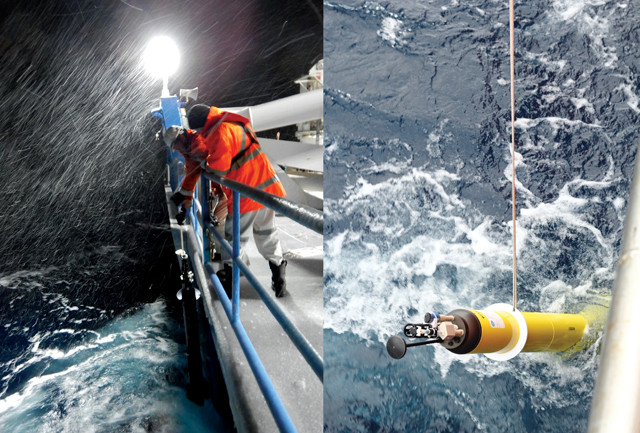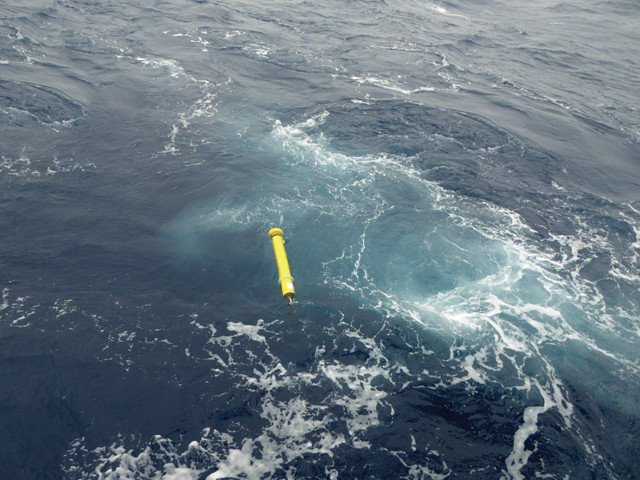
by Sarah Derouin Thursday, November 8, 2018

Since 2014, autonomous floats have been making continuous observations of the biogeochemical characteristics of the Southern Ocean. Scientists are using this information to make estimates of carbon fluxes to refine climate change models. Credit: left: Melissa Miller; right: Isa Rosso.
In the Southern Ocean surrounding Antarctica, complex and dynamic interactions among the atmosphere, cryosphere, and surface and deep ocean waters play an important role in climate. Although it covers only a quarter of Earth’s oceanic surface area, the Southern Ocean — with its cold temperatures and carbon-sucking algal blooms — has been estimated to take up 40 percent of anthropogenic carbon dioxide emissions. However, new data collected by a fleet of autonomous floating sensors show that the Southern Ocean is taking up significantly less carbon than scientists thought.
Previously collected shipboard data suggest the entire Southern Ocean can absorb as much as 1.3 billion metric tons of carbon dioxide per year. Despite its importance as a carbon sink, however, such data describing the Southern Ocean are sparse. “We have very few observations from there because it is hard to get there and it’s not a pleasant place to be, especially in the wintertime,” says Alison Gray, a physical oceanographer at the University of Washington and lead author of a new study in Geophysical Research Letters.
With technological advances, however, traditional shipboard data collection was no longer a necessity for Gray and her team. Instead, they used the floating sensors of the Southern Ocean Carbon and Climate Observations and Modeling (SOCCOM) project to continuously collect data describing the biogeochemistry of the near-surface ocean as well as its interactions with the atmosphere. The SOCCOM floats measure pH — an indirect indicator of carbon dioxide levels — along with levels of nitrate, dissolved oxygen, temperature, salinity, and fluorescence and biooptical backscatter (both of which reflect the presence of algae and other life). Nutrient levels, currents and surface winds all can influence carbon fluxes as well.
The researchers divided the Southern Ocean into five regions: the northernmost subtropical zone, the sub-Antarctic zone, the polar frontal zone, the Antarctic southern zone, and the southernmost seasonal-ice zone (which has the coldest surface waters and largest fluxes in salinity). The float observations revealed there was a seasonal relationship between carbon uptake and release, but it wasn’t always associated with the temperature changes that occur in summer versus winter.
The data also showed that the subtropical and sub-Antarctic zones experienced net carbon absorption — taking up about 0.35 and 0.01 billion metric tons of carbon per year, respectively — with uptake occurring in winter in the subtropical zone and in summer in the sub-Antarctic zone. The polar frontal zone and southernmost seasonal-ice zone, meanwhile, showed slightly more carbon release than uptake, with a net carbon release of about 0.01 billion metric tons from each.
In the Antarctic southern zone, the team found that the ocean was outgassing about 0.36 billion metric tons of carbon — a “pretty significant amount of carbon dioxide,” Gray says. “This was surprising because previous estimates, based on shipboard data, [suggested] that that region was not emitting anything,” she says.
The float observations show that with strong outgassing and upwelling, the entire Southern Ocean has a net annual carbon dioxide uptake of 0.08 billion metric tons a year. Not only are carbon emissions about 10 times higher than previously thought, carbon uptake is only one-tenth of what observations had suggested — which is “quite a big shift,” Gray says.

Floats are designed to survive at least three years in the inhospitable Southern Ocean. Data are available in nearly real time on the SOCCOM website. Credit: Cara Nissen.
The data collected from the floats are “an enormous step forward” in understanding ocean-atmosphere carbon exchanges because the floats make year-round data collection possible, even beneath the ice, says Richard Feely, a senior scientist at NOAA’s Pacific Marine Environmental Laboratory in Seattle, who was not involved in the study but is involved in the SOCCOM project. Understanding ocean carbon budgets has tremendous impacts on society, the economy and the environment, he says. A “decrease [in the ocean’s absorption of carbon] over time has serious implications for climate change and human welfare.” Feely says that the new data show the large-scale variability of carbon fluxes in oceans, information that can be used to refine climate models. His area of interest is the tropical Pacific — “the largest source of carbon dioxide to the atmosphere” — and he hopes that in the future this sort of monitoring can be used in other regions as well.
© 2008-2021. All rights reserved. Any copying, redistribution or retransmission of any of the contents of this service without the expressed written permission of the American Geosciences Institute is expressly prohibited. Click here for all copyright requests.